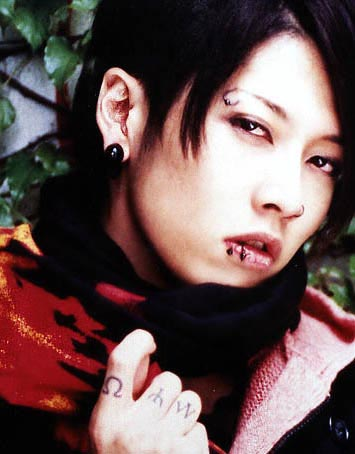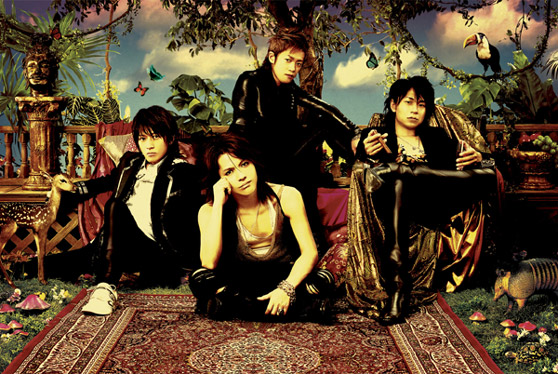Miyavi, born September 14, 1981 in Nishikujo, Konohana-ku, Osaka City, Japan,[2] is a Japanese solo rock artist and former guitarist (under the name Miyabi for the visual kei indies band Dué le quartz, which disbanded in 2002. In the same year, Miyabi announced that he was going solo, changed his name to Miyavi, and released his debut album Gagaku. He soon signed a contract with PS Company along with other artists such as Alice Nine, Kagrra, Gazette, and Kra.
In October 2004, Miyavi released his first major single Rock no gyakushuu -Superstar no jouken- (under Universal Records Japan) and began to credit himself in the songwriting credits in his liner notes as "Myv". His first major album, Miyavizm, was released in June 2005.
| Miyavi | |
|---|---|
| Also known as | 雅, Miyabi, Myv, 382[1] |
| Born | September 14, 1981 |
| Origin | Nishikujo, Konohana-ku, Osaka, Japan |
| Genre(s) | Rock Pop |
| Occupation(s) | Musician |
| Instrument(s) | Guitar, shamisen |
| Years active | 2002–present |
| Label(s) | PS Company/Universal |
| Associated acts | Skin, Dué le quartz |
| Website | O-re-sa-ma |

Biography
Early life
Miyavi was born in Nishikujo, Konohana-ku, Osaka City, Japan. His mother is Japanese and his father is a second generation Zainichi Korean[3][4] whose parents immigrated to Japan from the Korean island of Jeju. His family's Korean surname was Lee, (Korean: 이귀아, Hanja: 李貴雅) before changing it after moving to Japan. Miyavi has stated that though he has never been to Jeju he would like to do so when he has the opportunity.[5] Although Miyavi does not speak Korean he has expressed interest in learning the language sometime in the future.[6] Miyavi's parents divorced when he was young. Soon after, he moved with his mother to Hyōgo Prefecture (specifically, the city of Kawanishi) to live near his maternal grandparents, where he grew up. Miyavi claims that, as a child, he was a good student and enjoyed playing soccer.[2] Miyavi started playing the guitar and writing music when he was 15 after a soccer injury left him unable to play.[7][8]
Dué le quartz and Indies Era
In 1999, at the age of 18, Miyavi joined the visual kei band, Dué le quartz. The band broke up in September of 2002, and soon after Miyavi released his first solo album Gagaku under the indie label PS Company. Miyavi's significant change in music and visual styles since leaving Dué le quartz caused many of his original audience to disperse, but attracted a new audience.
Miyavi also starred as himself in the 2004 film Oresama and is regularly featured in various Japanese rock magazines such as Fools Mate, Arena 37c, and Shoxx magazine. In the past he has modeled in the Gothic & Lolita Bible and for various brands such as the clothing line Fotus.
In 2004 Miyavi was scheduled to perform at various conventions in the United States, but was forced to cancel last minute due to staff issues. One of the planned events had been a show at Pacific Media Expo, where the Japanese band Psycho le Cému acted as a substitute, while another was at Anime Central, where then-indies band Sid was booked as a replacement. He was also scheduled for Megacon, but no replacement was provided.
In 2004 the maxi-single Ashita, Genki ni Naare hit the number 1 spot on the Oricon indies chart.[9]
Majors and Pop/Acoustic Era
Following his signing with Universal Records Japan in late 2004, he changed his name to "Myv", an apparent shortening of "Miyavi", although magazines and his website still refer to him as "Miyavi" presently.
He released his first Majors single, Rock no Gyakushuu -Super Star no Jouken- in November 2004. He followed up this single with the release of his first Majors album, Miyavizm, in June 2005. Though Miyavizm holds the intense rock sound Miyavi was known for during his early career, after the album's release Miyavi began experimenting with different types of music.
In late 2005 and for most of 2006, Miyavi adopted a softer and more romantic feel to his music as he began producing more of an acoustic/pop sound. This change was reflected in his second and third Majors albums, Myv Pops and Miyaviuta ~Dokusou~, released consecutively in August and September of 2006. He has said of Myv Pops, "It's like putting all the songs that I created, presenting my own attitude towards "popularity", into one album."[10] Miyavi shortly followed up Myv Pops with the mostly acoustic album Miyaviuta ~Dokusou~, centered on the theme of love. Miyavi's focus on the Miyaviuta ~Dokusou~ album was to present himself as a performer. He says of this goal, "[...] for the album, [Miyaviuta ~Dokuso~] I wanted to fit in with the quality of the songs themselves and absorb myself into my performance, playing acoustic guitar alone."[11]
Miyavi showcased his new acoustic stylings for the first time in his "25 Shunen Kinen Koen Tokyo Geijutsu Gekijo 5 Days -Dokuso-" concert series held at Tokyo Geijutsu Gekijo in September 2006. The concerts, centered on his 25th birthday and spanning five days total, also featured a variety of background performers who accompanied Miyavi during his songs, among them tap dancers, percussionists, human beatboxers, taiko drummers, and painters.[12]
Commenting on the change in style from his earliers albums to his current albums, Miyavi has said, "Mostly I like low threshold music, which is popular, vulgar and foolish, and I like such lyrics too. But I also like more adult music too. As an artist, the worst thing for me is to be restrained and I don’t want to bind myself at all."[11]
Recent Events: US Debut, Neo Visualizm & Skin
On February 8, 2007, Miyavi announced via his online diary that he would be performing live in Las Vegas.[13] Due to short notice, only a number of fans were able to attend, but the event marked his musical debut in the United States. The mini-live took place at the Tabu Ultra Lounge in the MGM Grand on the night of February 17, 2007.[14]
On December 30, 2006 Miyavi put out a message that he would be joining a band.[15] At the time, he did not disclose the people he would be working with, but it was rumored that he would be joining the project of Gackt (Malice Mizer), Sugizo (Luna Sea) and Yoshiki (X Japan).[16] On May 25, 2007 at the J-rock Revolution concert organized by Yoshiki in Los Angeles, it was officially announced that Miyavi would indeed be a part of the "superband", named Skin[17][18] Skin, so far consisting of Yoshiki, Gackt, Sugizo, Miyavi himself, and possibly Ju-Ken (Gackt's touring bassist) performed their debut live at the 2007 Anime Expo convention in Long Beach, California on June 29, 2007.[19][20]
In May 2007, Miyavi announced his fourth major album--as well as his first remix album-- to be released in July. The album, titled 7 Samurai Sessions -We're Kavki Boiz-, will feature re-arrangements of his past songs and will feature a variety of instruments such as a turntable, various drums and tap dancing.[21] The limited edition of the album will include a DVD with bonus studio recording footage.[22] Miyavi's 7th major single (and 14th overall), a double A-side entitled Sakihokoru Hana no you ni -Neo Visualizm- / Kabuki Danshi, was released on June 20, 2007, and debuted at #4 on the Oricon Charts.[23] Miyavi's next tour, entitled "The Beginning of Neo Visualizm Tour", is scheduled to start on July 16th. So far, the tour is planned for twenty venues in Japan and a stop in Korea, and will last about six weeks, with its final show on September 2nd at Shinkiba Studio Coast. The tour will also feature the creative accompaniment team of performers (known as the "Kavki Boiz") seen with Miyavi during his "25 Shunen Kinen Koen Tokyo Geijutsu Gekijo 5 Days -Dokuso-" concerts.[24]
On September 3, a new single was announced. "Subarashikikana, Kono Sekai - What A Wonderful World" was released on November 14.[25]
Shortly after this release, Miyavi announced a new single, entitled "Hi no Hikari sae Todokanai Kono Basho de", which was released on January 16th. The single was a collaboration with fellow Skin guitarist, Sugizo.[26] This single, as well as the previous two will be featured on a new album entitled Miyavi -This iz The Japanese Kabuki Rock-.[27]
At a performance on December 25, Miyavi announced "This Iz the Japanese Kabuki Rock Tour 2008", his first world tour.[28] Although tour dates have yet to be released, Miyavi will be performing in Germany, America, England, France, Finland, Taiwan, Japan, China, and South Korea.
Discography
With Dué le Quartz
Albums
- Gagaku (October 31, 2002)
- Galyuu (December 2, 2003)
- Miyavizm (June 1, 2005)
- Myv Pops (August 2, 2006)
- Miyaviuta ~Dokusou~ (September 13, 2006)
- 7 Samurai Sessions -We're Kavki Boiz- (July 18, 2007)
- Miyavi -This iz The Japanese Kabuki Rock- (March 19, 2008)
Singles
- Shindemo Boogie-Woogie (November 30, 2002)
- Pop Is Dead (November 30, 2002)
- Jingle Bell (December 18, 2002)
- Jibun Kakumei -2003- (April 16, 2003)
- Tariraritarara (June 25, 2003)
- Coo quack cluck -Ku. Ku. Ru- (September 3, 2003)
- Ashita, Genki ni Naare (June 23, 2004)
- Rock no Gyakushuu -Super Star no Jouken- / 21 Seikigata Koushinkyoku (October 20, 2004)
- Freedom Fighters -Icecream wo Motta Hadashi no Megami to, Kikanjuu wo Motta Hadaka no Ousama- (May 4, 2005)
- Kekkonshiki no Uta ~Kisetsu Hazure no Wedding March~ / Are you ready to Rock? (October 12, 2005)
- Señor Señora Señorita / Gigpig Boogie (January 18, 2006)
- Dear my friend / Itoshii hito (April 12, 2006)
- Kimi ni Negai Wo (July 5, 2006)
- Sakihokoru Hana no You Ni -Neo Visualizm- / Kabuki Boiz (June 20, 2007)
- Subarashikikana, Kono Sekai - What A Wonderful World (November 14, 2007)
- Hi no Hikari sae Todokanai Kono Basho de (January 16, 2008)
DVD
- Gekokujou (1st Live Concert DVD) (July 23, 2003)
- Oresama (First Movie) (February 25, 2004)
- Hitorigei (PV Collection) (August 21, 2004)
- Indies Last Live In Nihon Budokan (2nd Live Concert DVD) (December 1, 2004)
- Noriko no Ichi (Budokan Documentary DVD) (January 12, 2005)
- Hitorigei 2 (2nd PV Collection) (December 7, 2005)
- Hitorigei 3 (3rd PV Collection) (December 20, 2006)
- 25 Shunen Kinen Koen Tokyo Geijutsu Gekijo 5 Days -Dokuso- (3rd Live Concert DVD) (May 2, 2007)
VHS
- Shibuya Kokadi (concert)









